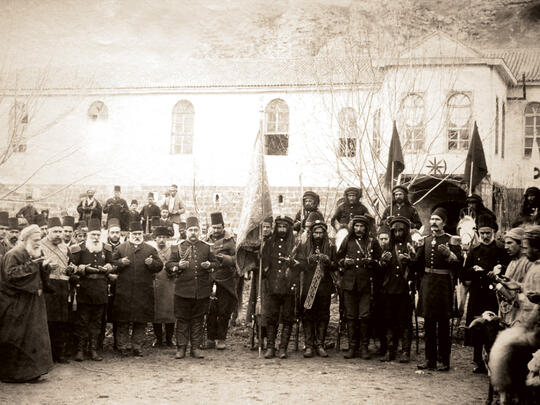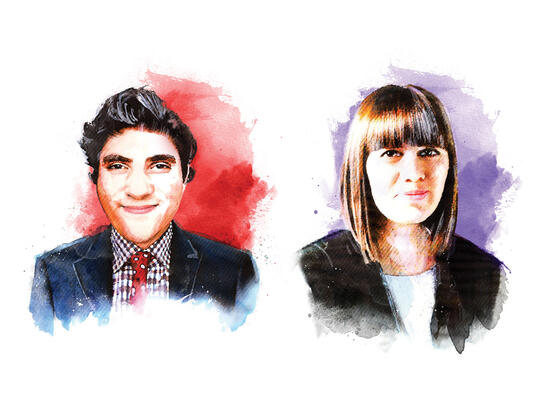The destruction of the Ottoman Armenian community brought about a modern diaspora characterized by tremendous geographic and cultural diversity. The Nubarian Library reflects the new diasporic reality shaped by the genocide and the new obligations that it created for Armenian institutions concerned with saving national history from the consequences of dispersion and oblivion. Boghos Nubar Pasha, one of the founding members of the Armenian General Benevolent Union (AGBU), established the library in 1928 in Paris where he and the AGBU Central Board had been based since World War I.
Until 1951, the Nubarian Library was under the directorship of Aram Andonian, the driving force in the development of its first archival collections. Andonian was ideally suited for the position. A former journalist for the Armenian press of Constantinople, he was already well known before the war for several of his publications, including a five-volume history of the Balkan War. Andonian was also well acquainted with members of the former Ottoman Armenian intellectual elite in Constantinople. Victim of the arrests and imprisonment of Armenian community leaders and intellectuals on April 24, 1915, Andonian was one of the few survivors.
After the war, he worked as the secretary for the Armenian National Delegation in Paris and undertook a project to publish a series of documents and accounts in Armenian, French and English of the extermination of the Armenians in the Syrian and Mesopotamian deserts. In 1921, Boghos Nubar Pasha sent him to Berlin to attend the trial of Soghomon Tehlirian, a genocide survivor being tried by a German court for killing Talaat Pasha, the Minister of the Interior under the Committee of Union and Progress that ruled the Ottoman Empire in its final years. Andonian assisted Tehlirian’s lawyers in providing them with information on the massacres and deportations.
The Nubarian Library quickly grew thanks to the many political figures and men of letters in the diaspora who bequeathed their collections. Conceived as both a center for Armenian and Middle Eastern studies and as a site for Armenian intellectuals to exchange ideas, the library also sought, from the very beginning, to contribute to resolving the era’s most pressing national concerns with the goal of achieving Armenian post-war political demands and bringing about a cultural renaissance. It is in this context—at a time in the 1920s and 1930s when the political focus was on preserving the elements of a nation in exile—that the efforts made to amass a diverse archive on Armenian affairs should be understood.
Over the course of its nearly 90 years, the Nubarian Library—along with the Calouste Gulbenkian Library of the Armenian Patriarchate of Jerusalem and the libraries of the Mekhitarist Congregations in Venice and Vienna—has become one of the main research centers in the Armenian diaspora for the study of Ottoman Armenian and diaspora Armenian history. The archives at the Nubarian Library primarily concern 19th and 20th century history. Its importance in preserving Armenian heritage and the diversity of the research projects it has enriched explain the singular place it occupies today in the commemoration of the centenary of the Armenian Genocide.
The library houses more than 43,000 printed works, many of which were published in Venice and Constantinople in the 18th and 19th centuries. The Nubarian Library also distinguishes itself in the breadth of its periodical collection of more than one thousand titles, the majority of which date from the middle of the 19th century to the foundation of the Turkish Republic in 1923. The journals, brimming with information about the political situation in Constantinople during the Armistice period, are also valuable resources for scholars interested in Armenian Genocide studies. The collection becomes even more indispensable when it is noted that certain periodicals in the collection are no longer available in Istanbul today, bringing many researchers from Turkey to Paris.
In addition to the library’s books and journals, the Nubarian Library is home to a large collection of unpublished materials and gathers historical documents of great value in understanding contemporary Armenian history, including letters from the Armenian National Delegation, led by Boghos Nubar Pasha from 1913 to 1921, as well as news digests compiled by Andonian on the fate of Armenia during the negotiations at the Peace Conference of Paris at the end of World War I.
The library has also become the repository of an important part of the archives of the Armenian Patriarchate of Constantinople, removed from the city before the arrival of the Turkish nationalist forces in 1922. These archives, in their original form or on microfilm, contain numerous letters between the Patriarchs and the provinces of the Ottoman Empire in the 19th century, copies of official reports of the courts charged with trying members of the Committee of Union and Progress after the war as well as censuses conducted by the Patriarchate detailing the Armenian population and their properties on the eve of the genocide.
The Nubarian Library also houses an exceptional collection of accounts of genocide survivors compiled by Andonian as well as AGBU archives that report on the humanitarian initiatives the organization undertook in support of orphans and refugees, particularly in the Middle East and Soviet Armenia, in the 1920s and 1930s. Included in the collection are also over 10,000 photographs from the beginning of the 20th century that document the AGBU schools and orphanages in the Middle East and in the rest of the diaspora.
The richness of the Nubarian Library’s collection has given the center an immeasurable role in the preservation of Armenian cultural heritage and has placed it at the crossroads of research in several academic disciplines, the corpus of which has only grown in the past 30 years in the fields of history, literature, art history and musicology, among others. This intellectual activity is also illustrated by the Nubarian Library’s diverse publications and its regular collaboration on research projects that link institutions in Armenia with those in the diaspora. Recent publications include the Revue d’histoire arménienne contemporaine, publishing 7 volumes between 1995 and 2009; the Revue arménienne des questions contemporaines, publishing 15 volumes between 2004 and 2012; and Un siècle d’histoire de l’Union générale arménienne de bienfaisance, a two-volume illustrated survey of the history of the AGBU written by Raymond Kévorkian and Vahé Tachjian for the organization’s centennial. Since September 2013, the Nubarian Library has published Études arméniennes contemporaines, an academic, multidisciplinary journal in French and English that unites humanities and social sciences. In January 2015, the journal launched its website, becoming the first Armenian studies journal published both in print and electronically.
Beyond the scholarly community, the library remains a resource for individuals, journalists, documentarians, filmmakers and editors interested in contemporary Armenian history.
This year, the library has also contributed to the February 2015 issue of the magazine L’Histoire, a reference text for the wider French public and the educational community, and participated in organizing an exhibition at the Hôtel de Ville in Paris in April 2015 in commemoration of the centenary of the genocide.
Through its publications, expositions, seminars and conferences, the Nubarian Library has heeded the call of its mission to conserve and develop Armenian cultural heritage, contributing to the dissemination of knowledge.
Banner photo courtesy of Nubarian Library Archives
















